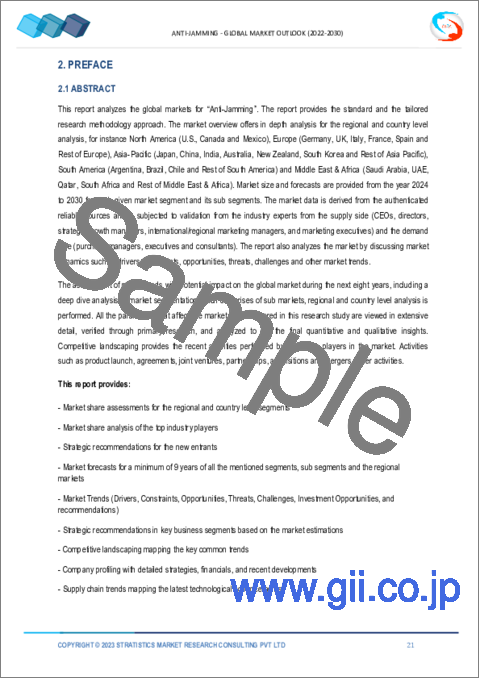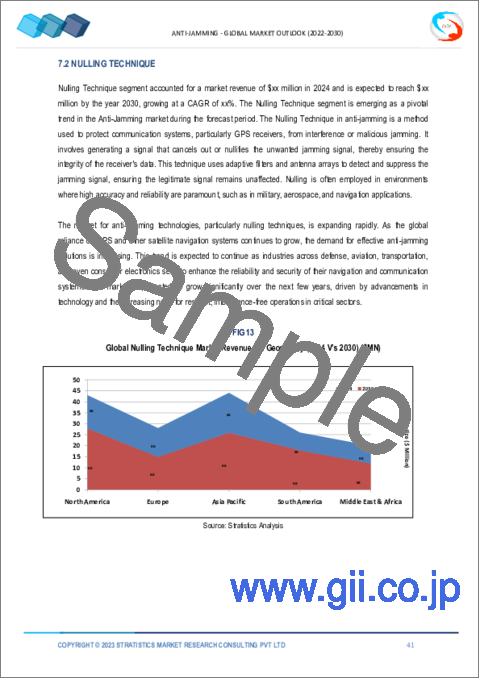|
|
市場調査レポート
商品コード
1324237
アンチジャミング(電波妨害対策)市場の2030年までの予測:受信機タイプ別、プラットフォーム別、技術別、用途別、地域別の世界分析Anti-Jamming Market Forecasts to 2030 - Global Analysis By Receiver Type, Platform, Technique, Application and By Geography |
||||||
カスタマイズ可能
|
|||||||
| アンチジャミング(電波妨害対策)市場の2030年までの予測:受信機タイプ別、プラットフォーム別、技術別、用途別、地域別の世界分析 |
|
出版日: 2023年08月01日
発行: Stratistics Market Research Consulting
ページ情報: 英文 175+ Pages
納期: 2~3営業日
|
- 全表示
- 概要
- 図表
- 目次
Stratistics MRCによると、世界のアンチジャミング(電波妨害対策)市場は2023年に53億米ドルを占め、予測期間中のCAGRは9.9%で成長し、2030年には102億8,000万米ドルに達すると予測されています。
アンチジャミング技術は、外部からの干渉やその他の障害からGPS信号を保護するために、GPS信号を増幅して強化する技術のサブセットです。この技術は急速に進化しており、主に商業目的で使用される可能性が高いです。また、この技術のおかげで干渉や障害物の影響が軽減され、GPS信号の適切な送受信が可能になります。
米連邦航空局(FAA)のドローン予測(2020~2040年)によると、2024年までに160万機のドローンが空を飛ぶと予想されています。米国だけでも、商業用ドローンの販売台数は2024年までに120万台に達すると予想されています。ドローンの商業利用の増加は、GPSメーカーに有望なビジネスチャンスをもたらす可能性があります。
GPSの軍事用途の需要が高い
世界のアンチジャミング市場は、予測期間中に成長を促進すると予想されます。世界的に、軍事ユニットは、正確なGPSナビゲーションを確保するための新しい、改良されたシステムを常に探しています。例えば、Mayflower Communicationsは2020年10月、GPSナビゲーションアンテナシステムで5,600万米ドルの契約を獲得しました。この技術は2024年9月に完成し、米国軍で使用される予定です。この契約の対象であるMulti-Platform Anti-Jam Global Positioning System(GPS)Navigation Antenna(MAGNA)は、GPSを保護します。さらに、英国国防省とRaytheon UKは2020年7月、最先端のGNSSアンチジャミング技術を開発する契約を締結しました。
GPS受信機が最新技術に対応できない
世界のアンチジャミング市場は、予測期間中の成長を妨げると予想されます。古いGPS受信機は、ビームフォーミング技術など、より最新の効果的なGPSアンチジャミング技術と互換性がありません。 ビームフォーマーは、妨害信号の方向に基づいて4つの衛星からの信号を認識、選択、ダウンリンクし、アルゴリズムの形式で 4 つの妨害対策ソリューションを提供します。ただし、4つの特定の衛星に向けられた4つの出力を生成するため、入力が1つしかない標準的なGPS受信機と接続することはできません。
無人システムとUAVの需要の増加
世界のアンチジャミング市場は、予測期間中に成長を促進すると予想されます。UAV技術の進歩により、航続距離とバッテリーバックアップが向上した軽量で耐久性のある無人機が製造されています。世界中の国々がUAVを監視、ナビゲーション、ターゲティング、ペイロード転送などのタスクに頻繁に使用しています。最近、ロシアが2022年10月に「シャヘド136」として知られるイランの無人機を400機以上使用したことが明らかになっています。
GPSスプーフィングを利用した攻撃
世界のアンチジャミング市場は、予測期間中の成長を妨げると予想されます。GPSスプーフィング攻撃は、標準的なGPS信号の特定のセットのように見せかけた偽の信号を放送することで、GPS受信機をだますことを含みます。別の場所や別の時間に記録された元の信号を再放送することも、これを実現する方法の1つです。これらの信号は、受信機を欺き、位置追跡を可能にするために変更することができます。GPSアンチジャミング市場のプレーヤーは、このようなGPSスプーフィング攻撃の結果、困難に直面しています。
COVID-19の影響:
アンチジャミング市場は、COVID-19の流行によって大きな影響を受けています。このパンデミックは、アンチジャミングシステムおよびコンポーネントの生産、流通、輸送を一時的に中断させました。このため、製品の発売、セットアップ、メンテナンスに遅れが生じ、市場の拡大が遅れています。しかし、ヘルスケア、防衛、政府は必要不可欠なサービスと考えられているため、パンデミックはこれらの分野でのアンチジャミングソリューションの需要も増加させています。アンチジャミング市場は、世界がパンデミックから回復し始めるにつれて、安全で信頼性の高い通信システムに対する需要の高まりに後押しされ、着実に拡大すると予想されます。
監視・偵察セグメントが予測期間中最大になる見込み
予測期間中、監視・偵察セグメントが最大のシェアを占めると予想されます。データや情報をリアルタイムで伝送するための安全で信頼性の高い通信システムへの需要が、アンチジャミング市場における監視・偵察セグメントの成長を促進する要因の1つです。通信システムに障害を与える意図的な妨害や非意図的な無線周波数干渉(RFI)から守るため、アンチジャミングシステムはこのセグメントに不可欠です。さらに、無人航空機(UAV)やその他の最先端監視技術の採用が増加し、国境警備、災害管理、法執行における用途の需要が高まっていることも、市場成長の拡大をもたらしています。
予測期間中にCAGRが最も高くなると予測される軍事セグメント
軍事セグメントは予測期間中に最も速いCAGR成長を示すと予測されています。軍事セグメントは、軍隊が使用するナビゲーションシステムや通信システムに対する妨害電波の影響を防止し、軽減するための戦略において重要な役割を担っています。軍事作戦中、指揮統制、情報共有、調整には安全で中断のない通信が不可欠であり、妨害電波対策技術は不可欠です。さらに、GPSのような衛星ベースのナビゲーションシステムは、軍用車両、航空機、人員の誘導に不可欠であるため、意図的な妨害から安全を守ることが極めて重要です。軍はこれらのシステムに依存しているため、軍独自の運用ニーズに適した信頼性の高いアンチジャミング製品の需要が高いです。
最大のシェアを持つ地域:
輸送、航空宇宙、軍事・防衛を含む多くのエンドユーザー産業でアンチジャミングシステムの採用が拡大しているため、現在、北米がアンチジャミング世界市場の予測期間中最大のシェアを占めています。多数の重要なアンチジャミングシステム生産者と供給者がこの地域に拠点を置いており、市場の拡大を促進しています。北米におけるアンチジャミング市場の成長は、意図的な妨害や意図的でない無線周波数干渉(RFI)を防ぐための高度なアンチジャミングシステムに対するニーズの拡大とともに、安全で信頼性の高い通信システムやナビゲーションシステムに対する需要の高まりによって牽引されています。
CAGRが最も高い地域:
予測期間中、アジア太平洋地域のCAGRが最も高いと予測されます。アンチジャミングソリューションと技術の主要な生産地および消費地であるアジア太平洋地域は、この分野にとって不可欠です。この地域では、通信システムやナビゲーションシステムに大きく依存する軍、政府機関、商業部門が幅広く存在するため、効果的なアンチジャミングソリューションの必要性が大きいです。アジア太平洋地域におけるアンチジャミング技術の採用は、国防費の増加、安全保障リスクの増大、軍用ハードウェアの近代化といった要素に影響されます。現地企業は最先端のアンチジャミングソリューションを開発・提供する機会を得ており、これが世界のアンチジャミング市場の全体的な拡大と競合を支えています。さらに、同地域の急速な経済成長と技術進歩も、地元企業にチャンスをもたらしています。
無料のカスタマイズサービス:
本レポートをご購読のお客様には、以下のいずれかの無料カスタマイズオプションをご提供いたします:
- 企業プロファイル
- 追加市場プレイヤーの包括的プロファイリング(3社まで)
- 主要企業のSWOT分析(3社まで)
- 地域セグメンテーション
- 顧客の関心に応じた主要国の市場推計・予測・CAGR(注:フィージビリティチェックによる)
- 競合ベンチマーキング
- 製品ポートフォリオ、地理的プレゼンス、戦略的提携に基づく主要企業のベンチマーキング
目次
第1章 エグゼクティブサマリー
第2章 序文
- 概要
- ステークホルダー
- 調査範囲
- 調査手法
- データマイニング
- データ分析
- データ検証
- 調査アプローチ
- 調査ソース
- 1次調査ソース
- 2次調査ソース
- 仮定
第3章 市場動向分析
- 促進要因
- 抑制要因
- 機会
- 脅威
- 用途分析
- エンドユーザー分析
- 新興市場
- 新型コロナウイルス感染症(COVID-19)の影響
第4章 ポーターのファイブフォース分析
- 供給企業の交渉力
- 買い手の交渉力
- 代替品の脅威
- 新規参入業者の脅威
- 競争企業間の敵対関係
第5章 世界のアンチジャミング市場:受信機タイプ別
- 軍事・政府グレード
- 商業輸送グレード
- その他の受信機タイプ
第6章 世界のアンチジャミング市場:プラットフォーム別
- 航空
- 陸上
- 海軍
- 宇宙
- その他のプラットフォーム
第7章 世界のアンチジャミング市場:技術別
- 無効化技術
- ビームステアリング技術
- 民間技術
- その他のテクニック
第8章 世界のアンチジャミング市場:用途別
- 飛行制御
- 監視・偵察
- 位置・ナビゲーション・タイミング
- ターゲティング
- 防衛
- 死傷者後送
- タイミング設置
- 物流追跡
- 法執行機関
- その他の用途
第9章 世界のアンチジャミング市場:エンドユーザー別
- 軍事
- 民間
- その他のエンドユーザー
第10章 世界のアンチジャミング市場:地域別
- 北米
- 米国
- カナダ
- メキシコ
- 欧州
- ドイツ
- 英国
- イタリア
- フランス
- スペイン
- その他欧州
- アジア太平洋地域
- 日本
- 中国
- インド
- オーストラリア
- ニュージーランド
- 韓国
- その他アジア太平洋地域
- 南米
- アルゼンチン
- ブラジル
- チリ
- その他南米
- 中東とアフリカ
- サウジアラビア
- アラブ首長国連邦
- カタール
- 南アフリカ
- その他中東とアフリカ
第11章 主な発展
- 契約、パートナーシップ、コラボレーション、合弁事業
- 買収と合併
- 新製品の発売
- 事業拡大
- その他の主要戦略
第12章 会社概要
- BAE Systems plc
- Chemring Technology Solutions Limited
- Cobham Ltd.
- Collins Aerospace
- Forsberg Services Ltd.
- Furuno Electric Co. Ltd.
- Harris Corporation
- Hexagon AB
- InfiniDome Ltd
- Israel Aerospace Industries
- L3Harris Technologies Inc.
- Lockheed Martin Corporation
- Mayflower Communications Company Inc
- Navcours Co., Ltd.
- Novatel Inc.
- Raytheon Technologies Corporation
- Rockwell Collins, Inc
- Thales Group
- The Boeing Company
- SpaceX
List of Tables
- Table 1 Global Anti-Jamming Market Outlook, By Region (2021-2030) ($MN)
- Table 2 Global Anti-Jamming Market Outlook, By Receiver Type (2021-2030) ($MN)
- Table 3 Global Anti-Jamming Market Outlook, By Military & Government Grade (2021-2030) ($MN)
- Table 4 Global Anti-Jamming Market Outlook, By Commercial Transportation Grade (2021-2030) ($MN)
- Table 5 Global Anti-Jamming Market Outlook, By Other Receiver Types (2021-2030) ($MN)
- Table 6 Global Anti-Jamming Market Outlook, By Platform (2021-2030) ($MN)
- Table 7 Global Anti-Jamming Market Outlook, By Airborne (2021-2030) ($MN)
- Table 8 Global Anti-Jamming Market Outlook, By Land (2021-2030) ($MN)
- Table 9 Global Anti-Jamming Market Outlook, By Naval (2021-2030) ($MN)
- Table 10 Global Anti-Jamming Market Outlook, By Space (2021-2030) ($MN)
- Table 11 Global Anti-Jamming Market Outlook, By Other Platforms (2021-2030) ($MN)
- Table 12 Global Anti-Jamming Market Outlook, By Technique (2021-2030) ($MN)
- Table 13 Global Anti-Jamming Market Outlook, By Nulling Technique (2021-2030) ($MN)
- Table 14 Global Anti-Jamming Market Outlook, By Beam Steering Technique (2021-2030) ($MN)
- Table 15 Global Anti-Jamming Market Outlook, By Civilian Technique (2021-2030) ($MN)
- Table 16 Global Anti-Jamming Market Outlook, By Other Techniques (2021-2030) ($MN)
- Table 17 Global Anti-Jamming Market Outlook, By Application (2021-2030) ($MN)
- Table 18 Global Anti-Jamming Market Outlook, By Flight Control (2021-2030) ($MN)
- Table 19 Global Anti-Jamming Market Outlook, By Surveillance and Reconnaissance (2021-2030) ($MN)
- Table 20 Global Anti-Jamming Market Outlook, By Position, Navigation, and Timing (2021-2030) ($MN)
- Table 21 Global Anti-Jamming Market Outlook, By Targeting (2021-2030) ($MN)
- Table 22 Global Anti-Jamming Market Outlook, By Defense (2021-2030) ($MN)
- Table 23 Global Anti-Jamming Market Outlook, By Casualty Evacuation (2021-2030) ($MN)
- Table 24 Global Anti-Jamming Market Outlook, By Timing Installation (2021-2030) ($MN)
- Table 25 Global Anti-Jamming Market Outlook, By Logistics Tracking (2021-2030) ($MN)
- Table 26 Global Anti-Jamming Market Outlook, By Law Enforcement (2021-2030) ($MN)
- Table 27 Global Anti-Jamming Market Outlook, By Other Applications (2021-2030) ($MN)
- Table 28 Global Anti-Jamming Market Outlook, By End User (2021-2030) ($MN)
- Table 29 Global Anti-Jamming Market Outlook, By Military (2021-2030) ($MN)
- Table 30 Global Anti-Jamming Market Outlook, By Civilian (2021-2030) ($MN)
- Table 31 Global Anti-Jamming Market Outlook, By Other End Users (2021-2030) ($MN)
Note: Tables for North America, Europe, APAC, South America, and Middle East & Africa Regions are also represented in the same manner as above.
According to Stratistics MRC, the Global Anti-Jamming Market is accounted for $5.30 billion in 2023 and is expected to reach $10.28 billion by 2030 growing at a CAGR of 9.9% during the forecast period. Anti-jamming technology is a subset of technology that works to amplify and fortify GPS signals in order to shield them from outside interference and other obstacles. This technology is rapidly evolving and will likely be used primarily for commercial purposes. Moreover, the effects of interference and obstructions are lessened thanks to this technology, enabling proper transmission and reception of GPS signals.
According to an FAA drone forecast (2020-2040), there will be 1.6 million drones in the air by 2024 commercial drone sales alone in the US are expected to reach 1.2 million by 2024. The increasing commercial use of drones may present a promising financial opportunity for GPS manufacturers.
Market Dynamics:
Driver:
Military applications for GPS are in high demand
The global Anti-Jamming market expected to drive growth during the forecast period. Globally, military units are constantly searching for new, improved systems to ensure precise GPS navigation. For example, Mayflower Communications received a USD 56 million contract in October 2020 for a GPS navigation antenna system. The technology is expected to be finished in September 2024 and will be used by the US military. The Multi-Platform Anti-Jam Global Positioning System (GPS) Navigation Antenna (MAGNA) that is the subject of this particular contract safeguards GPS. Moreover, the UK Ministry of Defence and Raytheon UK entered into a contract in July 2020 to develop cutting-edge GNSS anti-jamming technologies.
Restraint:
GPS receiver's inability to work with more modern technology
The global Anti-Jamming market expected to hinder growth during the forecast period. Older GPS receivers are incompatible with more modern and effective GPS anti-jamming techniques, such as beamforming technologies. Based on the direction of the jamming signals, the beam former recognizes, picks, and downlinks signals from four satellites and offers four anti-jam solutions in the form of algorithms. However, it cannot interface with a standard GPS receiver that only has one input because it produces four outputs that are directed at four specific satellites.
Opportunity:
Increasing demand for unmanned systems and UAVs
The global Anti-Jamming market expected to drive growth during the forecast period. UAV technology advancements have produced lightweight, durable drones with increased range and battery backup. Nations all over the world use UAVs frequently for tasks like surveillance, navigation, targeting, payload transfer, and so forth. It was recently revealed that Russia used more than 400 Iranian drones, known as "Shahed 136," in October 2022. These drones were reportedly carrying more than 2,000 weapons. However, Shahed 136 has anti-jam capability and can travel at a top speed of 185 kmph while carrying a 50 kg warhead. Therefore, the increasing use of UAVs in conflict has sparked an increase in airborne anti-jammers all over the world.
Threat:
Attacks using GPS spoofing
The global Anti-Jamming market expected to hamper growth during the forecast period. A GPS spoofing attack involves tricking a GPS receiver by broadcasting false signals that are made to look like a specific set of standard GPS signals. Rebroadcasting the original signals that were recorded somewhere else or at a different time is another way to achieve this. These signals can be altered to fool the receiver and make location tracking possible. For instance, on June 22, 2017, 20 Black Sea ships' GPS signals were hacked to reveal that they were 32 kilometers inland at Gelendzhik Airport. Players in the GPS anti-jamming market are facing difficulties as a result of such GPS spoofing attacks.
COVID-19 Impact:
The market for anti-jamming has been significantly impacted by the COVID-19 pandemic. The pandemic has temporarily disrupted the production, distribution, and transportation of anti-jamming systems and components. This has caused delays in product launches, setup, and maintenance, which has slowed the market's expansion. However, because healthcare, defense, and government are considered essential services, the pandemic has also increased demand for anti-jamming solutions in these sectors. The anti-jamming market is anticipated to expand steadily as the world begins to recover from the pandemic, driven by the rising demand for secure and dependable communication systems.
The surveillance and reconnaissance segment is expected to be the largest during the forecast period
The surveillance and reconnaissance segment is expected to be the largest share during the forecast period. The demand for secure and dependable communication systems for transmitting data and information in real-time is one of the factors driving the growth of the surveillance and reconnaissance segment in the Anti-Jamming market. As they guard against intentional jamming or unintentional radio frequency interference (RFI) that could impair communication systems, anti-jamming systems are essential for this segment. Additionally, rising adoption of unmanned aerial vehicles (UAVs) and other cutting-edge surveillance technologies, as well as rising demand for applications in border security, disaster management, and law enforcement results in the expansion of market growth.
The military segment is expected to have the highest CAGR during the forecast period
The military segment is anticipated to witness the fastest CAGR growth during the forecast period. The military segment is a vital part of the strategy to prevent and lessen the effects of jamming on the navigation and communication systems used by military forces. During military operations, secure and uninterrupted communication is essential for command and control, intelligence sharing, and coordination, making anti-jamming technologies essential. Additionally, satellite-based navigation systems like GPS are essential for guiding military vehicles, aircraft, and personnel; therefore, it is crucial to keep them safe from deliberate jamming. Because of the military's reliance on these systems, there is a high demand for reliable anti-jamming products that are suited to their unique operational needs..
Region with largest share:
Due to the growing adoption of anti-jamming systems across numerous end-user industries, including transportation, aerospace, and the military and defense, North America currently holds the largest share during the forecast period of the global anti-jamming market. Numerous significant Anti-Jamming system producers and suppliers are based in the area, which is fostering the market's expansion. The growth of the anti-jamming market in North America is being driven by the rising demand for secure and dependable communication and navigation systems, along with the expanding need for sophisticated anti-jamming systems to guard against intentional jamming or unintentional radio frequency interference (RFI).
Region with highest CAGR:
Asia Pacific is projected to have the highest CAGR over the forecast period. As a major producer and consumer of anti-jamming solutions and technologies, the Asia-Pacific region is essential to the field. The need for effective anti-jamming solutions is great in this area due to the wide range of military forces, governmental organizations, and commercial sectors that rely heavily on communication and navigation systems. The adoption of anti-jamming technologies in the Asia-Pacific region is influenced by elements like rising defense spending, growing security risks, and the modernization of military hardware. Local businesses have the chance to develop and offer cutting-edge anti-jamming solutions, which helps to support the overall expansion and competitiveness of the global anti-jamming market. Moreover, the region's rapid economic growth and technological advancements also present opportunities for local businesses.
Key players in the market:
Some of the key players in Anti-Jamming market include: BAE Systems plc, Chemring Technology Solutions Limited, Cobham Ltd., Collins Aerospace, Forsberg Services Ltd., Furuno Electric Co. Ltd., Harris Corporation, Hexagon AB, InfiniDome Ltd, Israel Aerospace Industries, L3Harris Technologies Inc., Lockheed Martin Corporation, Mayflower Communications Company Inc, Navcours Co., Ltd., Novatel In., Raytheon Technologies Corporation, Rockwell Collins, Inc, Thales Group, The Boeing Company and SpaceX.
Key Developments:
In January 2023, SpaceX launched a navigation satellite GPS 3 for U.S. Space Force. GPS 3 was built by Lockheed Martin with advanced anti-jamming capability.
In October 2022, InfiniDome introduced the GPSdome 2, a portable, affordable anti-jamming device that simultaneously shields dual frequencies from three attack directions for small- and large-scale applications. The product has been designed primarily to safeguard small to medium military UAVs with manned and unmanned ground vehicles.
In September 2022, Collins Aerospace has been given an IDIQ production contract with a ceiling value of USD 583 million under the Mounted Assured Positioning, Navigation, and Timing System (MAPS) Gen II program, in which the company has planned to use Collins' anti-jamming technology, M-code GPS, and NavFusion technology.
Receiver Types Covered:
- Military & Government Grade
- Commercial Transportation Grade
- Other Receiver Types
Platforms Covered:
- Airborne
- Land
- Naval
- Space
- Other Platforms
Techniques Covered:
- Nulling Technique
- Beam Steering Technique
- Civilian Technique
- Other Techniques
Applications Covered:
- Flight Control
- Surveillance and Reconnaissance
- Position, Navigation, and Timing
- Targeting
- Defense
- Casualty Evacuation
- Timing Installation
- Logistics Tracking
- Law Enforcement
- Other Applications
End Users Covered:
- Military
- Civilian
- Other End Users
Regions Covered:
- North America
- US
- Canada
- Mexico
- Europe
- Germany
- UK
- Italy
- France
- Spain
- Rest of Europe
- Asia Pacific
- Japan
- China
- India
- Australia
- New Zealand
- South Korea
- Rest of Asia Pacific
- South America
- Argentina
- Brazil
- Chile
- Rest of South America
- Middle East & Africa
- Saudi Arabia
- UAE
- Qatar
- South Africa
- Rest of Middle East & Africa
What our report offers:
- Market share assessments for the regional and country-level segments
- Strategic recommendations for the new entrants
- Covers Market data for the years 2021, 2022, 2023, 2026, and 2030
- Market Trends (Drivers, Constraints, Opportunities, Threats, Challenges, Investment Opportunities, and recommendations)
- Strategic recommendations in key business segments based on the market estimations
- Competitive landscaping mapping the key common trends
- Company profiling with detailed strategies, financials, and recent developments
- Supply chain trends mapping the latest technological advancements
Free Customization Offerings:
All the customers of this report will be entitled to receive one of the following free customization options:
- Company Profiling
- Comprehensive profiling of additional market players (up to 3)
- SWOT Analysis of key players (up to 3)
- Regional Segmentation
- Market estimations, Forecasts and CAGR of any prominent country as per the client's interest (Note: Depends on feasibility check)
- Competitive Benchmarking
- Benchmarking of key players based on product portfolio, geographical presence, and strategic alliances
Table of Contents
1 Executive Summary
2 Preface
- 2.1 Abstract
- 2.2 Stake Holders
- 2.3 Research Scope
- 2.4 Research Methodology
- 2.4.1 Data Mining
- 2.4.2 Data Analysis
- 2.4.3 Data Validation
- 2.4.4 Research Approach
- 2.5 Research Sources
- 2.5.1 Primary Research Sources
- 2.5.2 Secondary Research Sources
- 2.5.3 Assumptions
3 Market Trend Analysis
- 3.1 Introduction
- 3.2 Drivers
- 3.3 Restraints
- 3.4 Opportunities
- 3.5 Threats
- 3.6 Application Analysis
- 3.7 End User Analysis
- 3.8 Emerging Markets
- 3.9 Impact of Covid-19
4 Porters Five Force Analysis
- 4.1 Bargaining power of suppliers
- 4.2 Bargaining power of buyers
- 4.3 Threat of substitutes
- 4.4 Threat of new entrants
- 4.5 Competitive rivalry
5 Global Anti-Jamming Market, By Receiver Type
- 5.1 Introduction
- 5.2 Military & Government Grade
- 5.3 Commercial Transportation Grade
- 5.4 Other Receiver Types
6 Global Anti-Jamming Market, By Platform
- 6.1 Introduction
- 6.2 Airborne
- 6.3 Land
- 6.4 Naval
- 6.5 Space
- 6.6 Other Platforms
7 Global Anti-Jamming Market, By Technique
- 7.1 Introduction
- 7.2 Nulling Technique
- 7.3 Beam Steering Technique
- 7.4 Civilian Technique
- 7.5 Other Techniques
8 Global Anti-Jamming Market, By Application
- 8.1 Introduction
- 8.2 Flight Control
- 8.3 Surveillance and Reconnaissance
- 8.4 Position, Navigation, and Timing
- 8.5 Targeting
- 8.6 Defense
- 8.7 Casualty Evacuation
- 8.8 Timing Installation
- 8.9 Logistics Tracking
- 8.10 Law Enforcement
- 8.11 Other Applications
9 Global Anti-Jamming Market, By End User
- 9.1 Introduction
- 9.2 Military
- 9.3 Civilian
- 9.4 Other End Users
10 Global Anti-Jamming Market, By Geography
- 10.1 Introduction
- 10.2 North America
- 10.2.1 US
- 10.2.2 Canada
- 10.2.3 Mexico
- 10.3 Europe
- 10.3.1 Germany
- 10.3.2 UK
- 10.3.3 Italy
- 10.3.4 France
- 10.3.5 Spain
- 10.3.6 Rest of Europe
- 10.4 Asia Pacific
- 10.4.1 Japan
- 10.4.2 China
- 10.4.3 India
- 10.4.4 Australia
- 10.4.5 New Zealand
- 10.4.6 South Korea
- 10.4.7 Rest of Asia Pacific
- 10.6 South America
- 10.6.1 Argentina
- 10.6.2 Brazil
- 10.6.3 Chile
- 10.6.4 Rest of South America
- 10.6 Middle East & Africa
- 10.6.1 Saudi Arabia
- 10.6.2 UAE
- 10.6.3 Qatar
- 10.6.4 South Africa
- 10.6.5 Rest of Middle East & Africa
11 Key Developments
- 11.1 Agreements, Partnerships, Collaborations and Joint Ventures
- 11.2 Acquisitions & Mergers
- 11.3 New Product Launch
- 11.4 Expansions
- 11.5 Other Key Strategies
12 Company Profiling
- 12.1 BAE Systems plc
- 12.2 Chemring Technology Solutions Limited
- 12.3 Cobham Ltd.
- 12.4 Collins Aerospace
- 12.5 Forsberg Services Ltd.
- 12.6 Furuno Electric Co. Ltd.
- 12.7 Harris Corporation
- 12.8 Hexagon AB
- 12.9 InfiniDome Ltd
- 12.10 Israel Aerospace Industries
- 12.11 L3Harris Technologies Inc.
- 12.12 Lockheed Martin Corporation
- 12.13 Mayflower Communications Company Inc
- 12.14 Navcours Co., Ltd.
- 12.15 Novatel Inc.
- 12.16 Raytheon Technologies Corporation
- 12.17 Rockwell Collins, Inc
- 12.18 Thales Group
- 12.19 The Boeing Company
- 12.20 SpaceX






